

Vol. 40 (Number 27) Year 2019. Page 5
SHIRINKINA Elena 1 & STRIH Nikolay 2
Received: 15/04/2019 • Approved: 19/07/2019 • Published 05/08/2019
ABSTRACT: The Relevance of the study is due to the fact that the development of the digital economy stimulates significant reorganization of industrial enterprises, creates new requirements to the skills of workers and stimulates the demand for jobs in the digital technology industry. In this regard, companies are faced with the problem of reliable evaluation of the digital competencies of employees to develop managerial decisions in the direction of increasing the level of digitization. The Purpose of this study is to develop a methodology for assessing the digital competencies of industrial enterprises through neural network modelling. The Use of Neural network modeling is the process of training the neural net for its future application by the enterprise. The Practical significance of the proposed methodology is that the correct interpretation of the evaluation of competencies in the digital economy will allow companies to develop ways to improve the quality of human capital, which will provide it with a competitive Advantage. |
RESUMEN: La relevancia del estudio se debe a que el desarrollo de la economía digital estimula una reorganización significativa de las empresas industriales, crea nuevos requisitos para las habilidades de los trabajadores y estimula la demanda de empleos en la industria de la tecnología digital. En este sentido, las empresas se enfrentan al problema de la evaluación confiable de las competencias digitales de los empleados para tomar decisiones de gestión con el fin de aumentar el nivel de digitalización. El propósito de este estudio es desarrollar una metodología para evaluar las competencias digitales de los trabajadores industriales que utilizan el modelado de redes neuronales. El uso del método de modelado de redes neuronales consiste en el proceso de capacitación de una red neuronal para su uso futuro por parte de una empresa. La importancia práctica de la metodología propuesta es que la correcta interpretación de la evaluación de competencias en la economía digital permitirá a las empresas desarrollar formas de mejorar la calidad del capital humano, lo que le proporcionará una ventaja competitiva. |
Trends that contribute most to changing requirements of industrial workers-the formation of a "human gap" and the growth of demand for the "profession of the future", are related to the notion of digitization. In the next 10 years the transition of this process to the next phase is predicted: The key technologies of digitalization will be developed and ways of their introduction in strategic branches are worked out; As a result, the transition to massive digitalization of industries [Arntz, 2016] will begin. The Development of the digital economy stimulates significant reorganization of industrial enterprises, creates new requirements for workers ' skills and stimulates the demand for jobs in the digital technology industry. When any significant new technology emerges, employees and users need new skills to effectively use it and sustain potential productivity gains [Boyarov et. al., 2009].
The Competencies of employees are now an important tool for managing the human capital of enterprises, and the competency model is the backbone of the corporate human capital Management system. The Digitization of business processes and the use of information technology approaches offer new opportunities to assess workers as carriers of the human capital of industrial enterprises [Shirinkina, Kodintsev, 2018]. Necessity of development of digital competences of workers of industrial enterprises is caused by the following internal interrelated problems influencing all socio-economic systems:
-Formation of the personnel gap in the labor market. This is due, on the one hand, to the impending serious job cuts in many industries as a result of their digitization (in the ten-year period in the world can be reduced to 240 million jobs) and, on the other hand, the shortage of personnel in industries, Experienced growth. At the same time, the released personnel are mostly low-skilled and do not have enough skills to move to another industry [Colbert et. al., 2016];
-The need for mass retraining of the released workforce, which is primarily about the development of digital knowledge and skills that allow employees to adapt to the changed working processes and requirements of employers [Sirkin et. Al., 2015];
-The growing demand for the "profession of the future" arising from the modernization of industries, especially those related to the development and implementation of digital technologies, such as engineers and specialists in the maintenance of high-tech equipment [Frei and Osborn, 2013];
-The need to massively educate the staff on high-level cognitive skills-they include creativity, decision-making, problem solving, systemic analysis, critical thinking and leadership [Kelchevskaya, Shirinkina, 2016].
Today, the use of digital technologies is perceived by the top management of many Russian companies as a purely technological task. While the meaning of the happening digitalization is that not so much technology changes, but the system of human resources management, their competencies and organization of activity of the company itself.
These problems Update This study, the main research assumption of which is that the correct interpretation of the assessment of competencies of employees in the digital economy will allow companies to develop ways to manage Human resources and their competencies, which will provide it with a competitive advantage, an important tool of such management is the methodology proposed in this study for the evaluation of competencies using neural network modelling.
From the standpoint of modern theory and practice of management competence is considered as economic, legal, historical, philosophical, social, etc. Category. This is due to the fact that the competence approach is a complex, diverse and ambiguous process, which is in the context of socio-economic social development.
In the understanding of S. Uiddett and S. Holilliford Competence-it is the behavior demonstrated by man to improve the efficiency of the Enterprise [Whiddett, Hollyforde, 2003]. R. Boyyasis says: "Features that affect the effective work manifested in the general knowledge of Man, motives, features, vision of oneself and his social role and Skills" [Boyatsis, 2008]. Organizational and managerial approaches to the management of new digital knowledge and to the problems of the known boundaries of industrial enterprises are reflected in the study of Hecklau, F., Galeitzke, M., Flachs, S., Kohl, H. who claim: "... New strategic approaches to integrated human resources management are needed To cope with the knowledge and competence issues associated with new digital technologies and industrial processes in manufacturing companies " [Hecklau et. Al., 2016]. However, research is conducted only in the context of a strategic approach to staff development. The Distinguishing characteristic of a competent employee from a qualified person is not only the presence of certain knowledge, skills and competencies of a competent employee, but the ability to implement them in practice [Shirinkina, 2017].
The Development of the digital economy has led to qualitative changes in the management of enterprises, these cardinal changes that have been in the focus of theoretical and practical research for several decades [Akerlof, 1970; Aboody, 2000; Li et. Al., 2018], led to the formation of a new socio-economic paradigm. This paradigm shift has led to a further review of the role of human resources and their competencies in the enterprise. In the OECD's "Outlook For Digital Economy 2017" [OECD, 2017], digitization is seen as a catalyst for the development of business innovation. It carries many opportunities, but also creates new challenges, in particular, companies need to understand how to use the means of digitization to improve productivity, and how to develop the digital environment of the staff. Digital competencies have become an important requirement for employment in the digital environment, but a large proportion of the population still lacks the basic skills needed to function in the new digital world. According To OECD data, the lack of basic ICT skills and computer experience tends to occur in people aged 55-65 years, in people with a lack of full secondary education and in people with low qualifications. This lack of skills in the adult population is of particular concern because people with the weakest digital skills automatically fall into the risk group of losing work in the current technological transformation of the workforce. Thus, changes in the labor market affect those workers who have the lowest level of digital competencies, and those who are least prepared to upgrade their skills.
Global challenges in learning digital skills are linked to the transformation of a vision of priority to success in the digital environment of skill groups. Digital literacy is not limited to acquiring certain technical knowledge and skills. While technical competence remains the most sought-after, the importance of developed soft skills - social, behavioral, and cognitive - is increasing in order to successfully conduct business in digital environments and adapt to changing conditions. Within the framework of the action Plan for the Development of digital Education [DEAP, 2018], which came into effect in January 2018, the European commission focused on such aspects of digital competence as problem solving and cooperation in the digital environment. Similar tasks for transforming major skill groups are also highlighted in the World Economic Forum's analytical materials and the reports of corporate Analysis Services.
Today the question of digital literacy of the population, determined by the set of knowledge and skills, which are necessary for safe and effective use of digital technologies [Abakumova et. al., 2016; Abasheva et. Al., 2018]. Digital literacy is based On digital competencies — the ability to address diverse challenges in the use of information and communication technologies. Various State bodies, consulting companies and researchers have developed models of digital competencies/skills, which in many respects mutually complement each other. They provide the main directions for development: digital/information literacy, communication and cooperation, working with a large flow of information and solving problems that the machines will not be able to cope with. The Importance of digital skills for work and social integration is increasing. In the future they will be vitally needed. It is Already clear that the high level of employees with digital competencies at different levels in the company will provide it with a competitive advantage.
It is worth mentioning the shifting emphasis on the development of composite, integrated skills of cooperation and communication in the digital environment as opposed to narrowly understood computer literacy. It is important to consider digital skills that encompass ICT technical knowledge in close connection with soft skills and general knowledge. For Example, this approach is vividly illustrated by the "Target Competency Model 2025" prepared by BCG on the basis of consensus-opinion of experts [Butenko et. al., 2017; King et. Al., 2015] and analysis of approaches [Aptekman et. al., 2017], research of HSE "Digital skills of the population" [HSE, 2017], analytical report of the Corporate University of Sberbank [Katkalo et. al., 2018]. On the basis of these competences it is possible to allocate the basic directions for development:-Digital skills and knowledge. For example, basic digital literacy, data analytics, machine learning, artificial intelligence, programming, IT systems architecture, cyber security;
-Skills and knowledge that help to cope with the volatility and uncertainty of the future. For Example, adaptability, critical and systemic thinking, ability to cope with stress, change management, business planning, ability to self-learning in accordance with the concept of "lifelong learning";
-Skills and knowledge that help to cope with a large flow of information, including basic skills of programming, search, processing and analysis of information, information hygiene, media literacy, as well as management of attention;
-Skills and knowledge that define high communication skills for effective interpersonal interaction. For example, ability to work in a team, cooperation, self-presentation skills, business negotiation skills;
-Skills and knowledge that cannot be mastered by machines. For example, empathy and emotional intelligence, creativity and non-standard thinking, management of robotic processes.
In addition to the purely technical skills of working with digital devices, this model includes cognitive and socio-behavioural competencies aimed at ensuring a comfortable existence, effective communication and self-development of the person in Digital environment.
For Neural Network Modelling, when evaluating the digital competencies of employees, it is necessary to form a neural network as a dynamic system capable of generating output signals in response to the input neuron. It is a particular case of the method of image recognition, clustering and discriminant analysis, and from the standpoint of the multiparametric task of nonlinear optimization, the neural network training process is conducted for its future application. At the heart of neural network modelling lies an artificial neuron – a simplified model of a biological neuron. For the First time, the concept of an artificial neuron was formulated by Warren Mccalock in 1943, who first tried to simulate brain work [McCalloch and Pitts, 1943]. An Artificial neuron, similar to a biological neuron, has dendrites and axons. On dendrites Neuron receives a signal, axons serve for transformation of the information. Each neuron converts the signal in its own way, and since such neurons are billions, the input signal is converted to the correct output signal. Artificial Neural Network is a combination of artificial neurons interacting with each other.
An Artificial neuron, similar to a biological neuron, has dendrites and axons. On dendrites Neuron receives a signal, axons serve for transformation of the information. Each neuron converts the signal in its own way, and since such neurons are billions, the input signal is converted to the correct output signal. Artificial Neural Network is a combination of artificial neurons interacting with each other.
It Should be noted that when the mathematical models were born, computational power at that time could not even get closer to the modelling of natural biological neurons, but today it is possible. The Scheme of an artificial neuron represents a linear combination of a certain number of neurons. One of the important types of neuron is perceptron, which allows to simulate the process of perception. The First model of the Perseptron was proposed by Frank Rosenblatt in 1960 in the work of the neuro-computer "Mark-1". Perseptron is a neuron model, which is a feature of that it has this activation function, presented in Figure 1.
Figure 1
Model of the perceptron - an artificial neuron
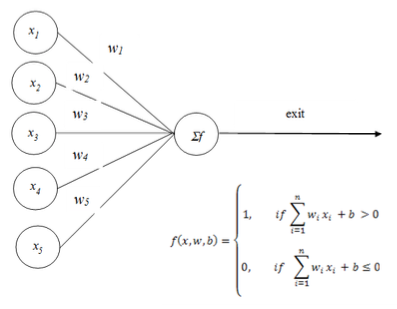
------
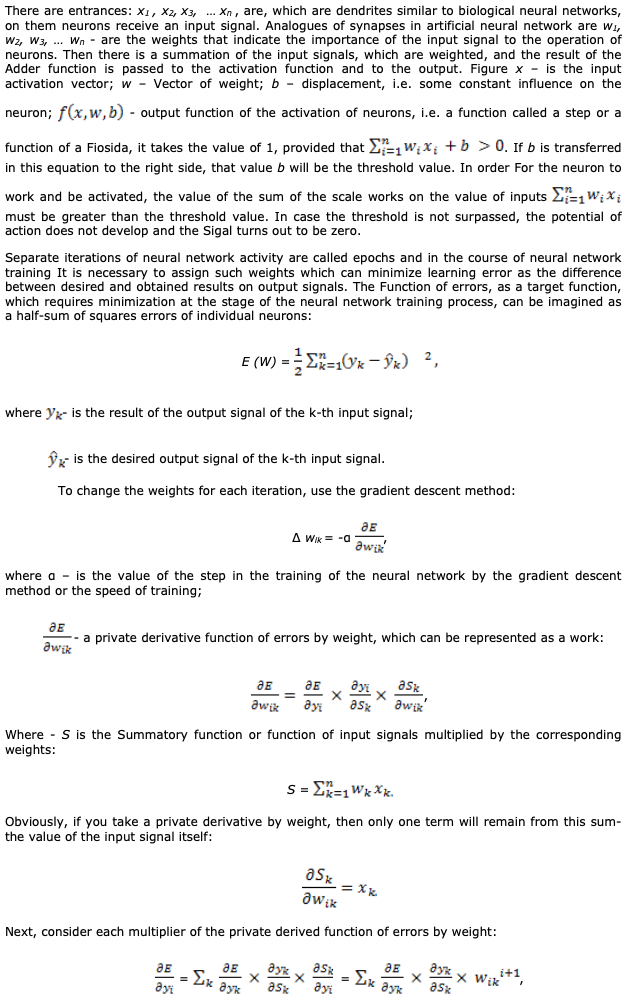

This algorithm of neural network training is called the algorithm of inverse propagation of the error, because first there is the error value in the last layer, then in the previous one, etc., thus each time it is necessary to adjust the weights of the neural network, and if The error for newly calculated values with new weights proves to be significant, then it is necessary to return to step 1 again, and with updated weights repeat all steps. Thus, it is gradually possible to obtain an agreement between the target signal value and the output of the neural network.
The Scheme of input data for neuromodelling in the proposed method of evaluation of the digital competencies of employees will have the form where each entry corresponds to one of the competencies of the proposed competency model (Fig. 2).
Figure 2
Employee competencies are input
signals for neural network modeling
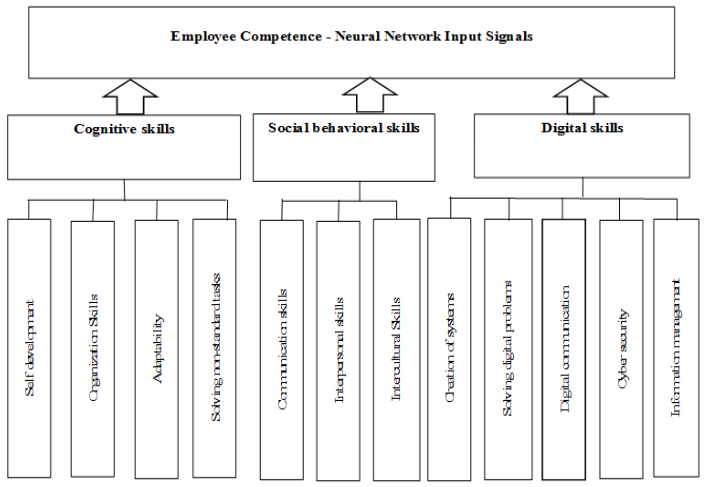
The input Signal is converted to the correct signal at the output, the peculiarity is that all neurons work on the same algorithm, in other words, within each neuron the signal is treated identically. However, the question arises: "Is there an individual conversion if the network response is always the same?". The Answer lies in the so-called synapses-the junction of the output of one neuron and the input of another, in which there is an amplification or weakening of the signal. Model Tasks – Output signals for the neural network in the proposed methodology of workers ' estimation are presented in Fig. 3.
Figure 3
Model objectives - output signals for a neural network
in the proposed methodology for evaluating workers
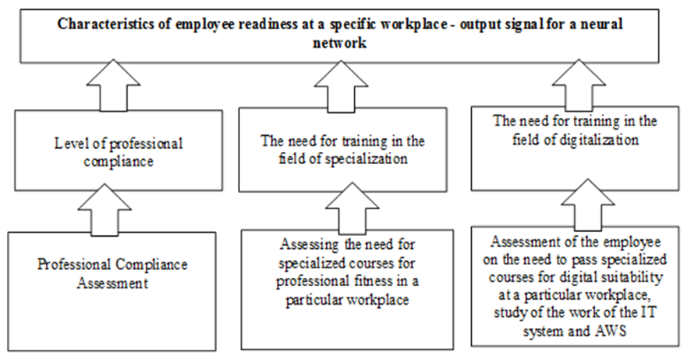
Changes caused by automation and digitalization of the environment change the principles of workplace organization:-from clearly defined work responsibilities to project work. Organizations employ most people in clearly defined working positions when the nature of responsibilities does not change significantly. But gradually the divisions in the field of marketing, finance, R&D and other functions cease to be limited to certain functional requirements and pass to the project approach and command self-organization. As a result, The organizational structure is changing — new work tasks, defined by technologies that go beyond the functions of the units, have a much shorter, project-oriented time frame and can radically change the approach to work Depending on the project.
-From hired work to independence from a certain employer. The Results of Bughin J., Lund S., Remes J. [Bughin et. al., 2016] show that about 25% of people who occupy traditional jobs would prefer to be independent workers with greater autonomy and less control over working Schedule. Digitization greatly facilitates the transition to independent or hybrid employment (combining traditional and independent work).
-From the evaluation of the qualification of employees by external characteristics (education and professional experience) to insights from deep analytics. The Level of education — especially in science, technology, engineering and mathematics (Science, Technology, Engineering and Mathematics — STEM) — is still considered a "marker" for hiring even in an age of digital technology. However, research does not find a confirmed correlation between the availability of educational degrees and professional success in work. At the same time, new changes require not only education and mastery of a certain set of skills, but also creativity, initiative, critical thinking, which are less connected with formal education, even in the field of STEM. As a result, recruitment Is changing and based on evaluation systems using big data analysis techniques.
Constructive and constructive approaches can be used When constructing a neural network. The Constructive way is that at first the network of the minimum possible size for the problem which is necessary for solving by means of a neural network is taken, and gradually, neuron behind a neuron, the degree of complexity of this network increases until there will be achieved the required accuracy, and at each step it is necessary to train a neural network.
If We talk about a destructive approach, there is a reverse process: first takes a network, notoriously inflated volume, and then it is gradually partially destroyed, ie gradually removed from it some nodes and links, which, in our opinion, As a result of analysis and training of such network are little influencing. One of the important rules of building neural networks is the following: the number of examples in the training set should be greater than the number of weights, otherwise, instead of generalizing the neural network will simply remember the data and lose the ability to Classification, i.e. in this case the result will not be defined for those examples which are not included in the training sample, and on the test set the neural network cannot work, as we expected.
When using neural networks as a classifier lead to a wide variety of configurations of neural networks, it allows the neural network to be considered a universal classifier, while neural networks allow approximate to any function with a high degree of accuracy. Regression models that are contained within a neural network enable efficient classification.
In binary classification, a task can be solved in a neural network with one neuron on the output layer, which can take one of two values: 0 or 1, depending on the accessory of the specimen to a particular class. Regardless of the use of the classification method when constructing a qualitative classifier, it is necessary to have qualitative data, i.e. if the set of examples is not sufficiently complete and representative, then no method, either statistical or Neural networks will not give a classifier of the desired quality.
The Interpretation of the results is as follows: The class number is determined by the network output number where the maximum value occurred. This method of encoding allows you to generate confidence in the correctness of the selected class, as the difference between the maximum output value and the value of the next output, and the higher the confidence (difference), the greater the likelihood of correct Response.
For Neural Network Modeling the software package "Neuralnet" is used, which provides flexible functionality of constructing classification and regression models based on the multilayer Perseptron.
Modelling was carried out on the basis of the data of attestation sheets of employees of PJSC "Surgutneftegaz" collected by the Center of Polytechnic training. The Task is based on data to divide most exactly employees into "professional compliance", "need training in specialization" and "need training in the field of digitization".
Neural Network Modelling was carried out sequentially in the following stages, including the following processes:
1) The Process of data collection and preparation, division into training and test sample;
2) The Process of data preprocessing and transformation for the input of the neural network;
3) The Process of construction and training of the network;
4) Network Diagnostics Process.
The First stage of neural network modelling consisted in preparation of the received data. The Center of Polytechnic training of PJSC "Surgutneftegaz" provided us with data on the results of attestation of employees without specifying their names and contact information with the decision on the assessment with a database of 150 people. The Initial data were divided into two sets, one of which 100 people. will be training (it was taught), another set of 50 people, was a test for verification.
The Second stage included the pre-processing of the available data and the process of converting them to feed into the neural network input. For the given problem of neuromodelling it is expedient to use the following structure of a neural network consisting of an input layer including 12 neurons (competences), and one output layer including one neuron (the answer on evaluation of competences Employee).
The System of output components looks like:
Y = {A,B,C},
where
A – Employee's assessment of the professional standard ("professional compliance");
B -the value corresponding to the employee who needs training in the field of specialization ("Specialization training is required");
C -the value corresponding to the employee who needs training in the field of digitization ("training is needed in the field of digitization").
Results of work with the program SNN are presented in figures 4-6, reflected received interfaces of the program. The input parameters Entered are reflected in Figure 4.
Figure 4
Fragment of the interface "Data: 13v by 150c"
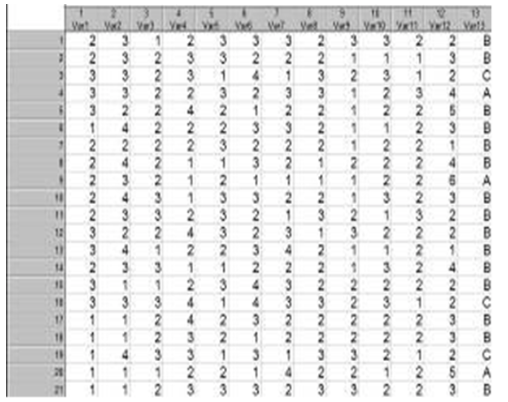
where input variables-competencies: Var 1 -self-development, Var 2-organization, Var 3-Adaptability, Var 4-the solution of non-standard tasks, Var 5-Communication, Var 6-interpersonal skills, Var 7-Intercultural interaction, Var 8-the creation of digital systems , Var9-Digital communications, Var 10 -Digital information management, Var 11 -solving digital problems, Var 12 -cyber security, Var 13 -The result of the output signal.

As a result of such training 10 neural networks are built, the best is determined by the value of verification error, the results are presented in Figure 5.
Figure 5
Learning outcomes of the neural network

The resulting network can be used to assess the digital competencies of employees.
In the fourth stage diagnostics and check of adequacy of neural network are carried out. To do this, in the "Predictions" tab We check the effectiveness of the received neural network by a test set consisting of 50 indicators (Fig. 6).
Figure 6
Results of the efficiency of the constructed neural network on the example of a test set
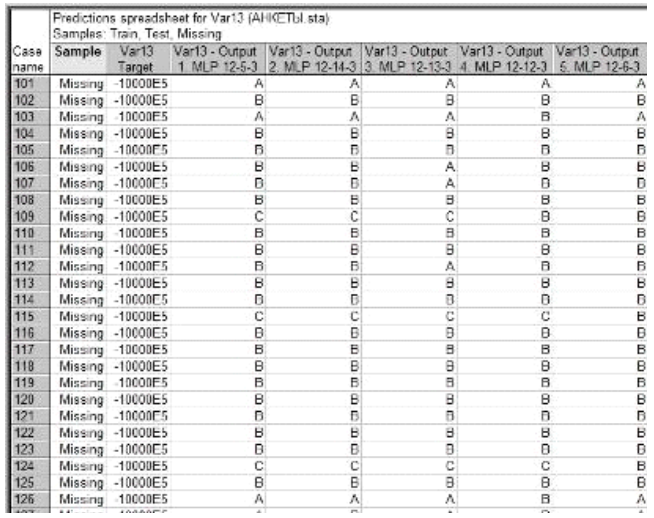
It is Obvious that the network MLP 12 \ u20125\u20123 with the architecture of multilayer Perseptron has a match with the test set of 87%, therefore, this neural network can be used to evaluate the digital competencies of employees. The sensitivity Analysis of the constructed and trained formal neural network to assess the digital competencies of employees showed the degree of influence of each factor on the result, the higher the rank corresponding to the variable, the greater its influence on the output Option.
The neural network Model for evaluating the digital competencies of employees is stored in the programming language "Save Networks > C/C++ language", which makes it possible to use it autonomously. To run a simulated neural network, use the "Dev-C + + 4.9.9.2" compiler.
The Conducted experiment on the existing sample of a neural network constructed with accuracy of 87% shows, that it satisfies the indicator of verification with the minimum quantity of correct predictions-80%. It allows to conclude about expediency of use of the given program by industrial enterprises for automated estimation of digital competences of workers of industrial enterprises by means of neural network modelling.
The Practical significance of the proposed methodology is that the correct interpretation of the evaluation of competencies in the digital economy will allow companies to develop ways to form high-quality human capital, which will provide them Competitive advantage.
This research is the starting point of large-scale work on defining new vectors in strategic management of human capital of industrial enterprises in the conditions of digital economy development.
Abakumova I.V., Antonova E.K., Baigulov R.M., Belyaeva, S.V. (2016). Nauchnye issledovaniya v sfere social'no-ehkonomicheskih i gumanitarnyh nauk: mezhdisciplinarnyj podhod i konvergenciya znanij [Scientific researches in the field of socio-economic and humanitarian sciences: interdisciplinary approach and convergence of knowledge], Samara, 369 р.
Abasheva O.Yu., Babina E.N., Bondarenko G.V. and others. (2018). Prikladnye, poiskovye i fundamental'nye social'no-ehkonomicheskie issledovaniya: integraciya nauki i praktiki. [Applied, search and fundamental socio-economic research: the integration of science and practice]. Samara: Etching.
Aboody D., Lev B. (2000). Information asymmetry, R&D, and insider gains. The journal of Finance, 6 (55), 2747-2766.
Akerlof G. (1970). The Market for 'Lemons': Quality Uncertainty and the Market Mechanism". Quarterly. Journal of Economics, 84 (3), 488-500.
Aptekman A., Kalabin V., Klintsov V., et al. (2017). Cifrovaya Rossiya: novaya real'nost' [Digital Russia: a new reality]. Digital McKinsey.
Arntz, M., Gregory T., Zierahn U. (2016). The Risk of Automation for Jobs in OECD Countries. A Comparative Analysis. [Onlain] Available: http://dx.doi.org/10.1787/5jlz9h56dvq7-en
Boyacis R. (2008). Kompetentnyj menedzher: model' ehffektivnoj raboty [Competent manager: effective work model. Per from English]. Moskva: GIPPO.
Boyarov A.D., Volkova M.N., Garafiev I.Z., Chernov S.S., Chirkova M.B. et al. (2009). Problemy ehkonomiki i upravleniya predpriyatiyami, otraslyami, kompleksami [Problems of economics and management of enterprises, industries, complexes]. Novosibirsk: SibAK., комплексами. Новосибирск: СибАК.
Bughin J., Lund S., Remes J. (2016). Rethinking work in the digital age. [Onlain] Available: https://www.mckinsey.com/business-functions/organization/our-insights/ rethinking-work-in-the-digital-age
Butenko V., Polunin K., Kotov I. and others. (2017). Rossiya 2025: ot kadrov k talantam [Russia 2025: from cadres to talents]. BCG.
Colbert A., Yee N., George G. (2016). The digital workforce and the workplace of the future. Academy of Management Journal, 59 (3), 731-739.
European Union. Digital Education Action Plan. (2018). [Onlain] Available: https://ec.europa.eu/education/policy/strategic-framework/educationtechnology_en
Facing the storm. Navigating the global skills crisis. (2016). IBM Institute for Business Value. [Onlain] Available: http://blog.oxfordeconomics.com/
Frei B., Osborn M. (2013). The future of employment: how susceptible are jobs to computerisation? [Onlain] Available: https://www.oxfordmartin.ox.ac.uk/downloads/academic/The_Future_of_Employment.pdf
Hecklau, F., Galeitzke, M., Flachs, S., Kohl, H. (2016). Holistic Approach for Human Resource Management in Industry, 54, 1-6.
Katkalo V.S., Volkov D.L., Baranov I.N., Zubtsov D.A., Lipchansky A.V., Sobolev E.V., Yurchenkov V.I., Starovoitov A.A. , Safronov P.A. (2018). Obuchenie cifrovym navykam: global'nye vyzovy i peredovye praktiki. Analiticheskij otchet [Digital skills training: global challenges and best practices. Analytical report]. Moskva: ANO DPO "Sberbank Corporate University", 136.
Kelchevskaya N.R., Shirinkina E.V. (2016). Monitoring sootvetstviya kompetencij vypusknikov vysshego obrazovaniya trebovaniyam rabotodatelej [Monitoring the compliance of competencies of graduates of higher education with the requirements of employers].Economy: yesterday, today, tomorrow, 12A (6), 121-129.
King M., Marshall А., Zaharchuk D. (2015). Pursuit of relevance: How higher education remains viable in today’s dynamic world. IBM Institute for Business Value. [Onlain] Available: http://ibm.com/business/value/ pursuitofrelevance (June, 2015)
Li L., Su F., Zhang W., Mao J.-Y. (2018). Digital transformation by SME entrepreneurs: A capability perspective. Information Systems Journal, 28(6), 1129-1157.
McCalloch W., Pitts W. (1943). A logical calculus of the ideas immanent in nervous activity. Bull. Math. Biophys, 5, 115–133.
OECD Digital Economy Outlook, (2017) [Onlain] Available: http://dx.doi.org/10.1787/9789264276284-en
Research Institute of the Higher School of Economics. (2017). Cifrovye navyki naseleniya [Digital population skills]. [Onlain] Available: https://www.hse.ru/monitoring/intel/news/207761941.html
Shirinkina E., Kodintsev A. (2018). Management of human capital in the national economy: Estimation and simulation. Revista Espacios, 44 (39), 28.
Shirinkina E.V. (2017). Kompetencii v federal'nyh gosudarstvennyh obrazovatel'nyh standartah vysshego obrazovaniya kak cel', orientirovannaya na zaprosy sovremennogo rynka truda Kompetencii v federal'nyh gosudarstvennyh obrazovatel'nyh standartah vysshego obrazovaniya kak cel', orientirovannaya na zaprosy sovremennogo rynka truda [Competences in the federal state educational standards of higher education as a goal, focused on the demands of the modern labor market]. Economics of Education, 3 (100), 44-57.
Sirkin H., Zinser M., Rose J. (2015). The Robotics Revolution. The Next Great Leap in Manufacturing. Boston: BCG.
Whiddett, S., Hollyforde S. (2003). A Practical Guide to Competencies: How to Enhance Individual and Organisational Performance. London: Chartered Institute of Personnel and Development.
1. Surgut State University, Lenin Street, 1, Surgut, Russia 628412. Email: shirinkina86@yandex.ru
2. Surgut State University, Lenin Street, 1, Surgut, Russia 628412